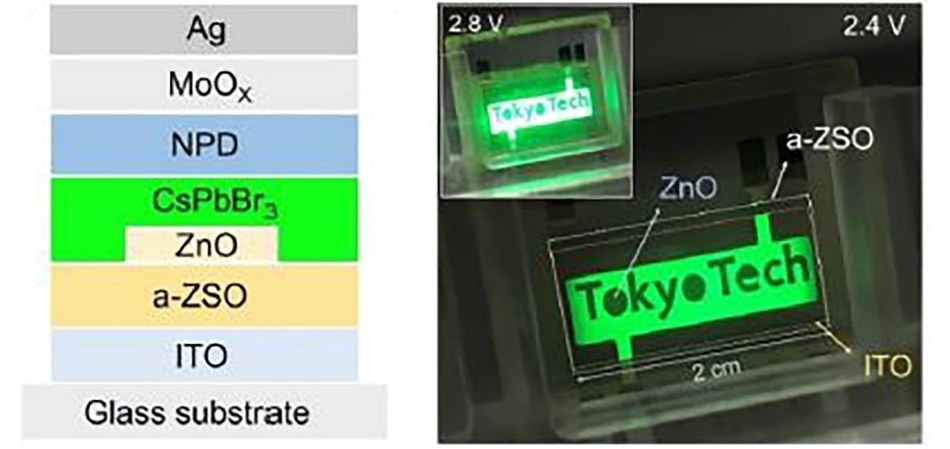Jul 31 2019
Progress in organic phosphorescent materials is paving the way for new opportunities using organic light-emitting diodes in combined electronics and light applications, including optical fibers, photodiodes, solar cells, and lasers.
 The structure of a large perovskite LED, where a layer of zinc oxide was deposited on the a-zinc silicate electron transport layer, providing greater brightness with better power efficiency. (Image credit: Tokyo Institute of Technology)
The structure of a large perovskite LED, where a layer of zinc oxide was deposited on the a-zinc silicate electron transport layer, providing greater brightness with better power efficiency. (Image credit: Tokyo Institute of Technology)
While low-dimensional luminescent materials, such as the calcium titanium oxide mineral perovskite, have favorable optical properties, their performance is still inadequate compared to conventional organic LEDs. A recent research, published in this week’s Applied Physics Reviews, from AIP Publishing, looks at a new method using an exciton confinement effect to enhance very efficient perovskite LEDs.
To realize an efficient electroluminescent device, it has to have a high photoluminescence quantum yield emission layer, high light out-coupling efficiency, and efficient electron hole injection and transport layers. With each new step forward in emission layer material, new functional materials are necessary to attain a more efficient LED.
To achieve this goal, the study authors investigated the performance of an amorphous zinc-silica-oxide system layered with perovskite crystals to enhance the diode performance.
We think that many people [are] too focused on an emission layer. For a device, all layers are equally important since each layer has a different [but] crucial role.
Hideo Hosono, Study Corresponding Author
The amorphous zinc silicon oxide has a shallow tunable electron affinity that can confine excitons. It also has high electron mobility to carry electrons. By layering the perovskite crystal and the amorphous zinc silicon oxide, the team created a method to confine excitons and inject the electrons into the 3D perovskite layers in an efficient manner. The energy-level alignment between the layers turned out to be a perfect material for this purpose.
To confirm their findings, the team tested their design by creating blue, red, and green perovskite LEDs, called PeLEDs. The green diode worked at the lowest voltage (2.9 volts at 10,000 candela per square meter) and was observed as the most efficient (33 lumens/watt) and brightest (500,000 candela per square meter). While the team created the maximum luminance for red diodes to date, the illumination stayed very dim for real-world application.
While these results demonstrate the promise of controlling the electron transport layer material, there are still a few challenges, including the toxicity of lead in the mineral crystal matrix and the stability of perovskite materials. In spite of these limitations, the results offer new prospects to apply this method to realize real-world applications for perovskite LEDs in optoelectronic devices.
For practical PeLEDs, new halide emitting materials with chemically stability and lead-free elements are highly needed. If this issue is solved, the PeLEDs would be commercialized for practical electronics in the future.
Junghwan Kim, Study Corresponding Author